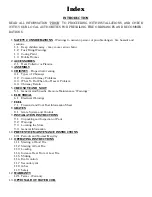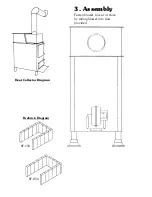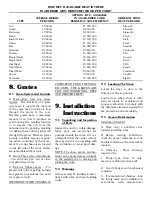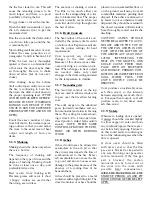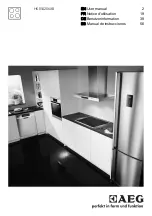
13
the fire has started to die. This will
cause the reloading process to be
much longer, and there is a good
possibility of losing the fire.
Do not shake or stir with a low fire.
Open the draft control wide or open
the ash cleanout door to get the
maximum draft.
Run the stove with the draft control
or ash door fully open until the fire
is reasonably hot.
Start adding small amounts of coal.
Follow the same procedure as in
paragraphs 3 and 4 in Section 11.2
When the new coal is thoroughly
ignited or there is a substantial bed
of hot coals, the stove may be shak-
en thoroughly. Be sure to shake
down all ashes (but do not over-
shake).
After shaking, keep the bottom
draft control open until you are sure
the fire is continuing to burn hot,
then turn the draft control down to
the proper operating level. IF THE
ASH DOOR HAS BEEN OPENED,
BE SURE TO SHUT IT (SERIOUS
DAMAGE CAN RESULT IF THE
STOVE IS RUN FOR EXTENDED
PERIODS WITH THE ASH DOOR
OPEN).
Count the exact number of turns
from full shut to the normal operat-
ing positions so that you can adjust
the stove to the exact level of heat
output and length of burn you
desire.
11.5 Shaking
Shaking should be done only when
there is a hot fire.
The frequency of shaking will
depend on the type of stove and the
degree of burning. Shaking should
be done at least once a day, and
preferably twice a day.
Best results from shaking with
Harman grates will occur if short
“choppy” strokes are used rather
than long, even strokes.
The amount of shaking is critical.
Too little or too much, either can
result in the extinguishing of a fire
due to blocked air flow. The proper
amount normally occurs when red
coals first start to drop through onto
the bed of ashes.
11.6 Draft Controls
The heat output of the coal is con-
trolled by the primary draft control
on bottom door. Experience will dic-
tate the proper settings for heat
requirements.
Coal responds very slowly to
changes in the draft settings.
Because of this slow response time,
over-correcting is a common prob-
lem. When changes in heat output
a re needed, make only small
changes in the draft setting and wait
for the temperature to stabilize.
11.7 Secondary Air
The two draft controls on the top
door are used to allow secondary air
to pass over the fire when burning
coal.
This adds oxygen to the unburned
gases (primarily methane and car-
bon monoxide) and aides in burning
them. The setting for normal burn-
ing is from 1/2 to 1 turn open from
closed position. Adjust both controls
equally. NOTE: THESE SAME
CONTROLS PROVIDE THE PRI-
M A RY AIR WHEN BURNING
WOOD.
11.8 Ashes
Ashes should never be allowed to
accumulate in the ash pit so that
they in any way impede the flow of
combustion air to the fire. Excess
ash accumulation can cause the fire
to go out and also can cause severe
damage to the grates because of the
absence of a cooling flow of air
beneath them.
Ashes should be placed in a metal
container with a tight fitting lid. The
closed container of ashes should be
placed on a noncombustible floor or
on the ground, well away from all
combustible materials, pending final
disposal. If the ashes are disposed of
by burial in soil or otherwise locally
dispersed, they should be retained in
the closed container until all cinders
have thoroughly cooled outside the
dwelling.
CAUTION! ASHES SHOULD
NEVER BE ALLOWED TO ACCU-
MULATE ABOVE THE TOP OF
THE ASH PAN. ASHES IN CON-
TACT WITH THE BOTTOM OF
THE GRATES ACT AS AN INSU-
L ATOR, INTENSIFYING THE
HEAT ON THE GRATES, AND
COULD CAUSE THEIR WA R -
PAGE. WITH AN EXCESSIVE
ASH BUILDUP, PRIMARY COM-
BUSTION AIR IS RESTRICTED (IN
COAL MODE); THUS, THE
UNIT’S OUTPUT COULD BE
REDUCED!
Coal produces considerably more
ash than wood, so the intervals
between emptying are much short-
er. For equal heat output, coal will
produce seven to ten times more
ash than wood.
11.9 Safety
Whenever a loading door is opened,
it always should be cracked slightly
to allow oxygen to enter and burn
any combustion gases that are pres-
ent before fully opening. Failure to
do this could result in sudden igni-
tion of the unburned gases when the
door is opened.
A stove never should be filled
with excess coal so that the flue
gas exit is blocked or impeded in
any way. Burning coal generates
carbon monoxide. If the flue gas
exit is blocked, the carbon
monoxide can be forced out of
the stove into the room, with
possible f a t a l
c o n s e q u e n c e s .
WITH THE EXCEPTION OF THE
START-UP PERIOD, AN ASH PIT
DOOR SHOULD NEVER BE LEFT
OPEN.
Summary of Contents for SF-150 SF-250
Page 18: ...17...



